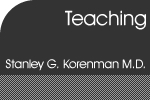

|
<< Previous Section | < Previous Page | Next Page > | Next Section >>
Bibliography (page 6 of 13) Friedman, P. J. (2002). "The Impact of Conflict of Interest on Trust in Science." Sci Eng Ethics 8(3): 413-420. This paper is a deep analysis of the corrosive effects of conflicts of interest on trust in schience, with the public and even among investigators. This lack of trust can have an adverse effect on the scientific record as well. Disclosure, our major method of dealing with COIs is really inadequate even if it were well-and completely carried out. We need new rules and new approaches and the author discusses some possibilities. He points out that managing COIs is not institutions of learning's best suite and that institutions can get into COI problems themselves. Gelijns, A. C. and S. O. Thier (2002). "Medical Innovation and Institutional Interdependence: Rethinking University-Industry Connections." JAMA 287(1): 72-77. The authors attempt to present a balanced account of the great benefits associated with Industry-Academic collaborations in research and development and the negative impacts of the relationships. This paper reviews institutional patterns of innovations and suggests organizational and public policy implications. This is important reading because many of the papers in this area deal with the negative aspects of university-industry relations and do not deal with the importance of these collaborations for advances. Hahn, R. (2002). "Conflicts of Interest and the False Comfort of "Full Disclosure"." Professional Ethics Report 15(4). The concept that revealing conflicts of interest in all presentations and publications eliminates their insidious effects on research. Not true, this article claims. The problem is that other mechanisms of control severely limit the incomes of successful scientists. Hall, S. S. (2001). Claritin and Schering-Plough: A Prescription for Profit. The New York Times. New York. March 11, 2001. This article purports to show that Schering used inadequate science to demonstrate that a mediocre antihistamine was less soporific than the older variety and therefore supplanted the older versions at great cost to society. Ironically, branded clariton sells well as an over-the -counter antihistamine even though it is expensive. Hart, D. (2002). "The "Corporatization" of Science." Science 295: 439. This letter reviews the history of the support of basic research after WWII and reviews the changes in the scientific community that supported Bayh-Dole and indicated the importance of continuing attention to the new relationships developing as a result. Horton, R. (2004). "The Dawn of McScience." The New York Review. This review of Seldon Krimsky's book Science in the Private Interest: Has the Lure of Profits Corrupted Biomedical Research? The reviewer indicates that Krimsky produced a polemic indicating that declaring conflicts of interest will not solve the problems but that the separation of science from industry never truly existed and that, to some extent, the moral requirement to tell the truth in science was always blemished when it related to practical products. The Nancy Oliveri case, as well as the purchase of investigators and physicians by gift giving of pharmaceutical houses, are thoroughly discussed. I think that we are moving in the direction of balance by now, but my naivete may be showing. Johns, M. M. E., M. Barnes, et al. (2003). "Restoring Balance to Industry-Academia Relationships in an Era of Institutional Financial Conflicts of Interest: Promoting Research While Maintaining Trust." JAMA 289(6): 741-746. This paper deals with University-Industry relationships from the point of view of the research managers and other leaders at academic institutions. The authors discuss divestiture, firewalls and other methods to ensure that industrial affiliations do not corrupt the activities of the university and adversely affect the public trust. << Previous Section | < Previous Page | Next Page > | Next Section >> |
Chapter 4 Quick Links Conflicts of Interest (COI) Definitions Consequences of a COI Government Intervention Industry Sponsorship Professional Societies Clinical Practice Guidelines Other Initiatives COI in Financial Consulting Cases Bibliography Chapter 4 Download (PDF) |